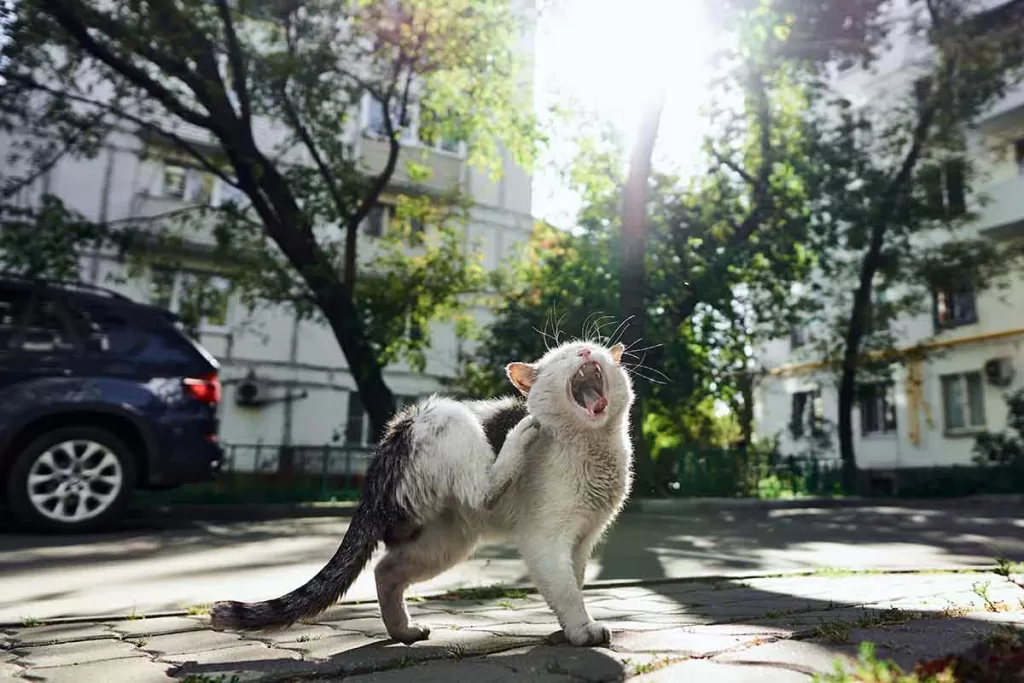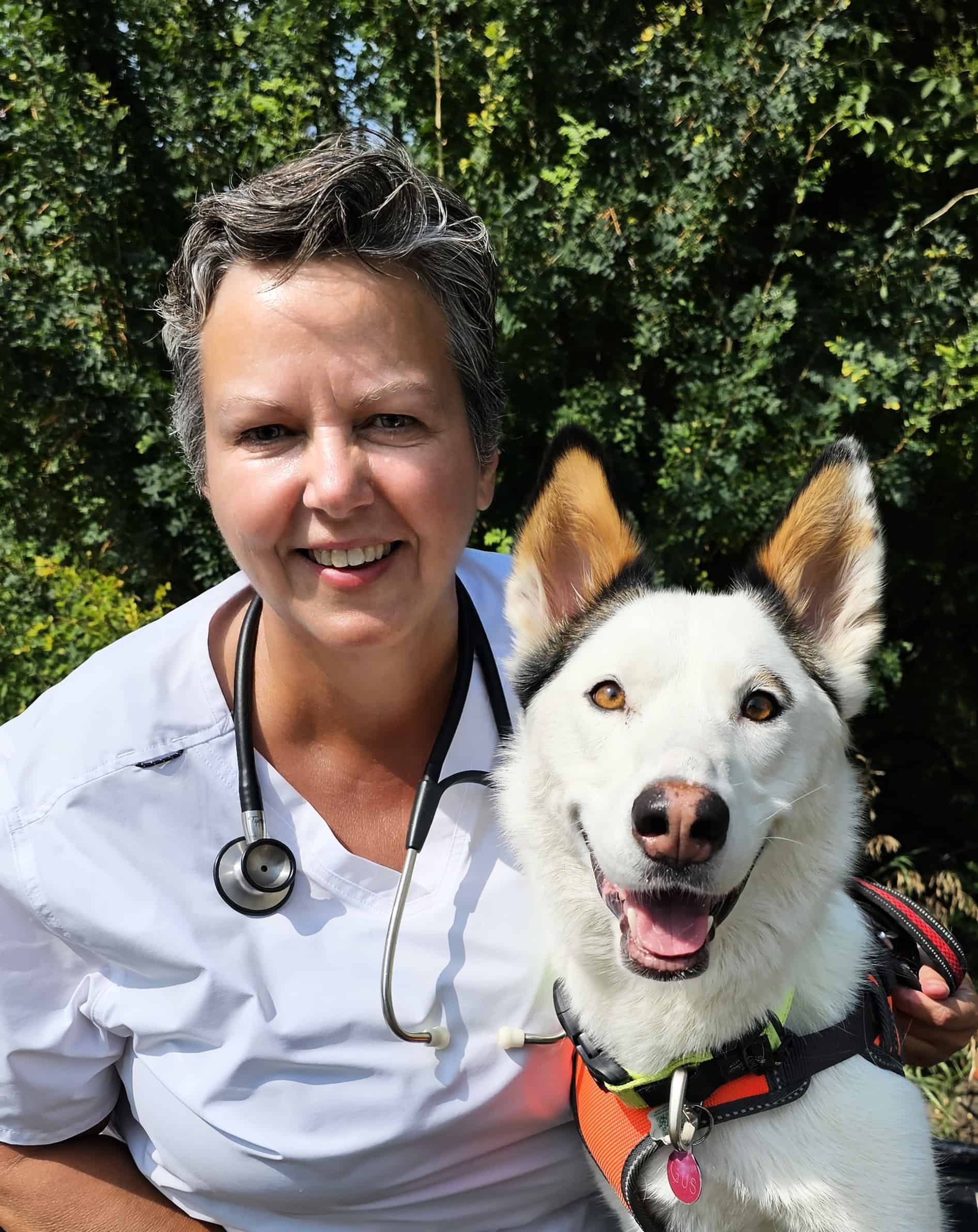Last updated on March 24th, 2024 at 09:11 am
Cats, like dogs, can get fleas. Flea infestations cause cats a lot of discomfort and can even lead to more serious health issues. But how do cats get fleas in the first place?
Cats can pick up fleas from direct contact with flea-infested animals such as other cats, dogs, or wildlife. They can also pick them up from the environment (indoors and outdoors) since flea pupae can live for months without a host – they just lie in wait until a likely host walks by.
In this article, we’ll explore how cats get fleas so you’ll be better equipped to protect your pets from them.
Overview Of The Flea Life Cycle
Understanding how cats get fleas starts with knowing how fleas reproduce and spread. The life cycle of a flea involves four stages: egg, larva, pupa, and adult. Knowing each stage can help you better protect your cat from these pesky parasites:
- Adult fleas mate and lay eggs (on the host or the environment) after taking a blood meal from a host (e.g. a cat).
- Eggs hatch in 1-10 days depending on environmental conditions. Larvae seek out hidden areas such as cracks in the floor and the folds of bedding.
- The larvae can move around while they continue developing. They feed on blood and flea feces (flea poop!), then form a cocoon and enter the pupa stage.
- The cocooned pupae are very resistant to drying and insecticides and can survive in this stage for up to 5-9 months. They will remain in this cocoon until the presence of a host is detected via movement or body host. Adult fleas emerge only when there is a host present.
- Females feed from the host soon after emerging, then mate and lay eggs, renewing the cycle all over again.
The flea pupae’s ability to lie dormant for months at a time is one of the main reasons why flea infestations can be so difficult to control.

How Cats Get Fleas
There are two main ways that cats get fleas: directly from other animals and the environment.
Fleas From Other Animals
Any time your cat comes into contact with another animal, they have a chance of picking up fleas. Most commonly this happens with outdoor cats, who have the opportunity to interact with a number of different animals.
However, indoor cats can also get fleas from other animals, such as from other pets in the house, other people’s pets that come into your home, and even from house invaders like mice.
Indoor cats can also get fleas from other animals they meet if they need to be taken out of the home for any reason. This includes trips such as veterinary visits, the groomer, or boarding kennels.
Fleas From The Environment
Another way cats get fleas is through the environment. As already mentioned, flea pupae can survive in the cocoon for up to 5-9 months and then emerge when they detect a host nearby.
If your cat goes outdoors, it can easily pick up fleas when it comes near pupae that are lying dormant in the environment.
Flea pupae can be found in soil, in the grass, in animal burrows, and outdoor kennels and beds, among other places. All the cat has to do is walk by these areas and it can pick up some fleas.
Indoor cats can in the same way pick up fleas from their environment if there are pupae present in the home. These can be tracked in on furniture, shoes, clothes, or carpets from outside.
Can Cats Get Dog Fleas?
In North America and many other parts of the world, the most common flea on both cats and dogs is the cat flea (Ctenocephalides felis). This flea lives happily on either species and readily jumps between them if given the opportunity.
The dog flea (Ctenocephalides canis) is present in some areas and, while it can live on cats, it is not common for them to do so. This flea is most often found outdoors, on animals housed in outdoor kennels and on wild canids. It represents about 20% of canine flea infestations.

Tips For Preventing Your Cat From Getting Fleas
Prevention is the best medicine when it comes to cat fleas. Some things that you can do to protect your cat are:
- Keep outdoor time to a minimum.
- Avoid contact with any wild or stray animals.
- Keep your pet’s hygiene in check with regular baths and brushing.
- Check for fleas often, especially during warmer months.
- Chat with your vet to find the appropriate flea control method for your pet.
- Stay on top of flea treatments year-round to stop flea infestations in their tracks and prevent new ones from sprouting up.
How Do I Know If My Cat Has Fleas?
Likely the first sign you will notice that your cat has fleas is scratching. If your cat has been scratching at itself frequently, it’s time to do a full-body check for fleas.
You can start by checking the skin around the base of their tail, under their armpits, and in their groin region. Part the hair so you can get a good look at the skin.
Look for little black dots that seem to be on the move. Also look for skin irritation, redness, scabs, and hair loss.
You can also check for flea droppings (flea dirt). Place your cat on a white pillowcase or large piece of white paper, and brush their fur with a flea comb. If dark specks come off onto the white surface, that is probably fleas or dried flea poop.
If you are still unsure, collect some of the dirt and place it on a damp paper towel or cotton ball. Flea droppings consist largely of blood and will dissolve into rusty red spots when wet.
Finally, if your cat has fleas you probably have a flea infestation in your house. Fleas will bite humans as well. Flea bites on people can be small, red, and itchy. They are typically found around the ankles and legs, as this is where fleas tend to feed on humans.
Flea bites can cause skin irritation and discomfort, as well as pain for those with more sensitive skin. In some cases, people may experience an allergic reaction.
If you suspect that your cat has fleas, it’s best to take them to the vet right away so they can provide you with an accurate diagnosis and treatment options.
How To Treat Cat Fleas
Treat Your Cat For Fleas
If your cat does have fleas, it’s important to take action quickly – fleas reproduce quickly and can cause your cat a great deal of distress.
Talk to your vet about the best flea control options for your pet. They usually involve some kind of topical treatment, such as a shampoo, dip, or spot-on treatment containing an insecticide. Your vet can help you determine the best flea control option for your pet’s size, age, and health needs.

Treat Your Home For Fleas
You will need to treat your home and other places your cat spends time as well. Some products for killing fleas in the environment contain insect growth regulators (IGRs) that kill flea eggs, which are very difficult to control with traditional treatments.
Before treating your home with an insecticide, you will need to thoroughly clean and vacuum your home to get rid of as many remaining fleas and their eggs as possible. The fewer fleas and eggs there are before you treat, the better the chances of complete eradication.
You will need to wash all pet bedding in the hottest water possible, vacuum carpets and furniture thoroughly, and mop any hard floors. Fleas like dark areas around the house, so make sure to pay extra attention to those spots when cleaning.
If you have had your cat in your car, you will need to do a similar cleaning there. Don’t forget your bed and bedroom, if that is a place your cat where your cat spends time.
Once you have cleaned your home thoroughly, you can apply an insecticide to help get rid of any remaining fleas. Two or more treatments after the first treatment should be done to ensure that all the fleas and eggs have been killed.
Finally, once you have done all this work, keep up with regular flea prevention to make sure the fleas don’t come back and cause more problems for you and your cat. Take it from someone with experience – you do not want to have to repeat this whole process again!
The Last Kick At The Cat (in other words: Conclusion!)
Cats get fleas from two sources – other animals, and the environment. It is important to be aware of how cats get fleas so that you can take steps to protect your pet, as well as yourself.
It’s important to take action quickly if you suspect your cat has fleas. Talk to your vet right away and start a treatment plan for both your pet and its environment.
Follow through with regular treatments and cleanings, and continue with preventive measures throughout the year to make sure your cat stays healthy and flea-free!
Disclaimer: This article is intended for information purposes only, and does not constitute medical advice. Always consult your veterinarian if you have specific concerns about your pet’s health.


